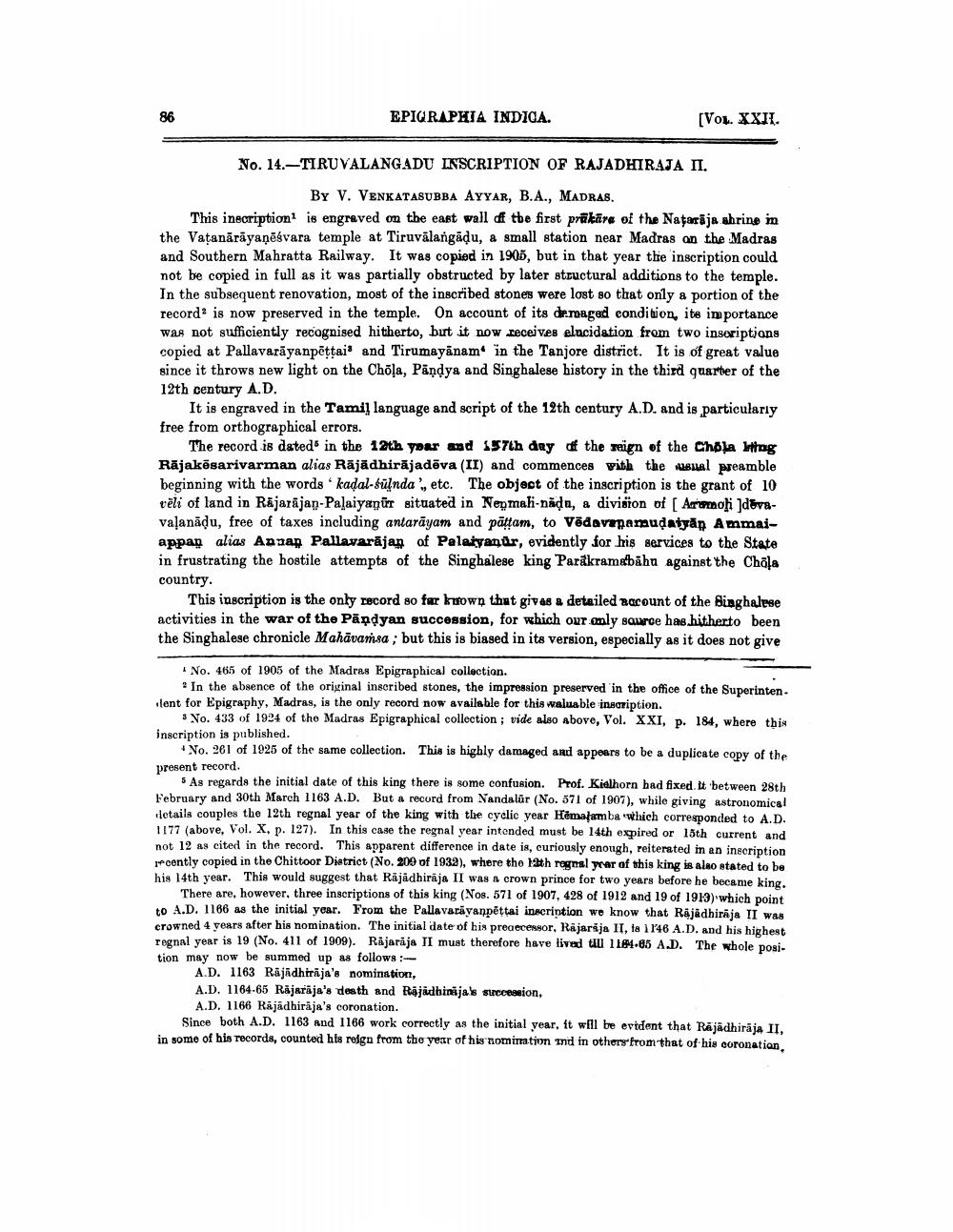________________
EPIGRAPHIA INDICA.
[VOL. XXII.
No. 14.- TIRUVALANGADU INSCRIPTION OF RAJADHIRAJA II.
BY V. VENKATASUBBA AYYAR, B.A., MADRAS. This inscription is engraved on the east wall of the first prikāre of the Nataraja shrine in the Vatanārāyaņēśvara temple at Tiruvālangādu, a small station near Madras on the Madras and Southern Mahratta Railway. It was copied in 1905, but in that year the inscription could not be copied in full as it was partially obstructed by later structural additions to the temple. In the subsequent renovation, most of the inscribed stones were lost so that only a portion of the record is now preserved in the temple. On account of its deroagad condition, its importance was not sufficiently recognised hitherto, but it now receives elucidation from two insoriptions copied at Pallavarāyanpottai' and Tirumayānam in the Tanjore district. It is of great value since it throws new light on the Chola, Pandya and Singhalese history in the third quarter of the 12th century A.D.
It is engraved in the Tamil language and script of the 12th century A.D. and is particularly free from orthographical errors.
The record is dated in the 12th year and 17th day of the reign of the Chola ling Rājakõsarivarman alias Rājādhirājadēva (II) and commences with the usual preamble beginning with the words kadal-Sülnda, etc. The object of the inscription is the grant of 10 vēli of land in Rājarājan-Palaiyaņār situated in Nep mahi-näda, a division of Acromoli ]devavaļanādu, free of taxes including antarāyam and pātam, to Vēdav pamudatyān Ammaiappan alias Annan Pallavarājan of Palatyanür, evidently for his services to the State in frustrating the hostile attempts of the Singhalese king Parakramabāhu against the Chala country.
This inscription is the only record so far hown that gives a detailed racount of the Singhalese activities in the war of the Pandyan succession, for which our mly source has hitherto been the Singhalese chronicle Mahāvamsa ; but this is biased in its version, especially as it does not give
No. 465 of 1905 of the Madras Epigraphical collection.
? In the absence of the original inscribed stones, the impression preserved in the office of the Superinten. lent for Epigraphy, Madras, is the only record now available for this waluable inscription.
3 No. 433 of 1934 of the Madras Epigraphical collection ; vide also above, Vol. XXI, p. 184, where this inscription is published.
No. 281 of 1925 of the same collection. This is highly damaged and appears to be a duplicate copy of the present record.
As regards the initial date of this king there is some confusion. Prof. Kialhorn had fixed. It between 28th February and 30th March 1163 A.D. But a record from Nandalar (No. 371 of 1907), while giving astronomical details couples the 12th regnal year of the king with the cyclic year Hématamba which corresponded to A.D. 1177 (above, Vol. X, p. 127). In this case the regnal year intended must be 14th expired or 15th current and not 12 as cited in the record. This apparent difference in date is, curiously enough, reiterated in an inscription
cently copied in the Chittoor District (No. 209 of 1932), where the 19th regnal year of this king is also stated to be his 14th year. This would suggest that Rajadhiraja II was a crown prince for two years before he became king.
There are, however, three inscriptions of this king (Nos. 571 of 1907, 428 of 1912 and 19 of 1913) which point +0 A.D. 1166 as the initial year. From the Pallavarayanpettai inscription we know that Rajadhiraja II was crowned 4 years after his nomination. The initial date of his predecessor, Rajaraja 11, 1a 1146 A.D. and his highest regnal year is 19 (No. 411 of 1909). Rajaraja II must therefore have lived till 1164.85 A.D. The whole position may now be summed up as follows:
A.D. 1163 Rajadhiraja's nomination, A.D. 1164-65 Rajarāja's death and Rajadhinaja's succession,
A.D. 1166 Rajadhiraja's coronation.
Since both A.D. 1163 and 1166 work correctly as the initial year, it will be evident that Rajadhiraja II, in some of his records, counted his reign from the year of his nomination and in others from that of his coronation.




